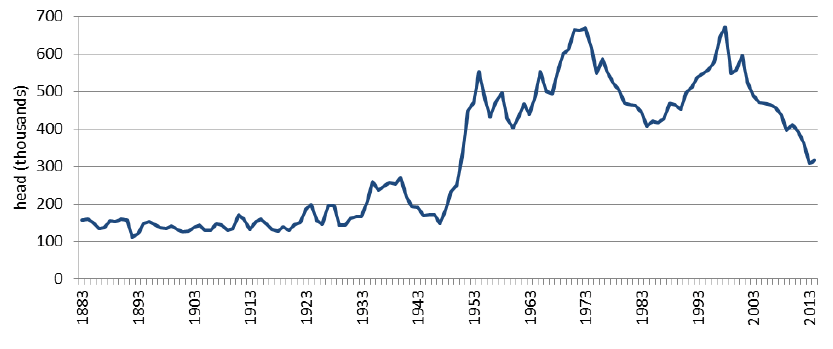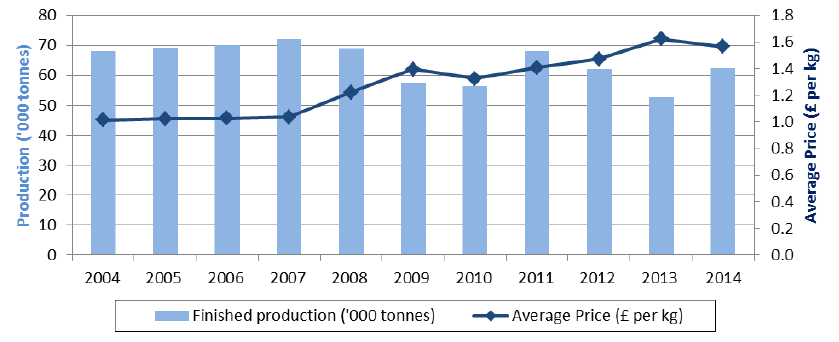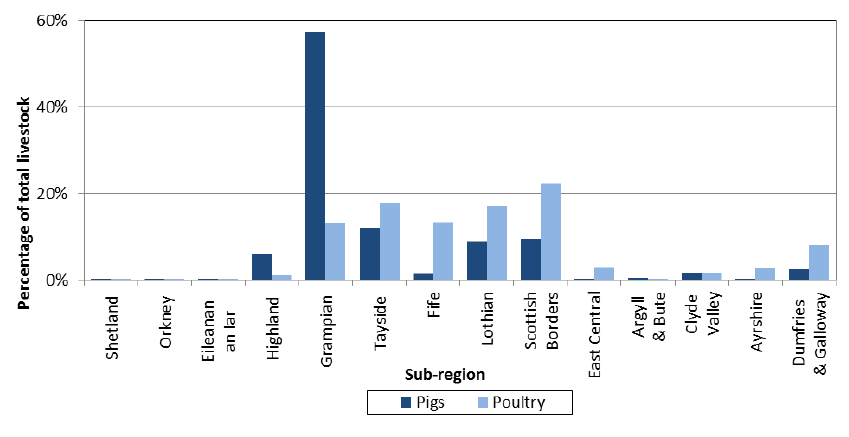Economic Report on Scottish Agriculture 2015
Economic Report on Scottish Agriculture 2015 presenting an overall picture of Scottish agriculture using data from the various agricultural surveys that RESAS manage.
This document is part of a collection
5.4 Pigs
There were 316,000 pigs in Scotland in June 2014. The number increased sharply in the 1950s, peaking in the early 70s and late 90s, with numbers in general decline since then.
Chart 5.20: Number of pigs in Scotland 1883-2014

5.4.1 Distribution of pigs (Table C10(i), C10(ii))
Chart 5.23 shows that the majority of pigs were located in Grampian (181,400 pigs or 57 per cent). Tayside, Lothian, Highland and Scottish Borders each accounted for between six per cent and 12 per cent of the total number of pigs in Scotland.
5.4.2 Pig herd size (Tables C15, C16)
The pig sector is highly concentrated. In June 2014 nine per cent of pig holdings accounted for 86 per cent of the total number of female breeding pigs (46 holdings each having more than 250 female breeding pigs, with 26,000 breeding pigs, out of a total of 30,200). Conversely, 74 per cent of holdings accounted for just over two per cent of female breeding pigs (390 holdings with fewer than five female breeding pigs each, and 725 between them).
This structure is similar for fattening pigs, with 15 per cent of holdings accounting for 98 per cent of fattening pigs (115 holdings with herds of 100 and over accounting for 186,900 of the 190,900 fattening pigs in Scotland). Likewise there were 73 per cent of holdings accounting for less than one per cent of the total number of fattening pigs (576 holdings with herds of fewer than ten). In the case of both breeding and fattening pigs, this concentration of larger herds is greatest in the North East, where the majority of pigs in Scotland are located.
5.4.3 Income from pigs (Table A6)
Pigs accounted for about three per cent of output from farming. The value of income from pigs increased by £28 million (42 per cent) between 2004 and 2014; the 2014 value was £94 million (see chart 5.1). Income has seen several rises over the period, particularly in 2011 and 2014. Between 2011 and 2013 values fell by 12 per cent, but rose again in 2014 by £15 million (19 per cent), due to an increase in numbers.
Between 2004 and 2014 total pig-meat production fell by 5,600 tonnes (eight per cent), (see chart 5.2). Including cull of older animals, production in 2014 was at 62,000 tonnes. A large increase in production (as well as price) in 2011 to 68,000 tonnes had the effect of making the decreases in following years appear larger than a comparison with the trend would suggest. Chart 5.21 shows data for finished pig production, excluding older livestock.
Chart 5.21: Finished pig production and average price, 2004-2014

Over the past ten years there have been increases in the price of finished pigs, up from an average of £1.01 per kg in 2004 to £1.57 per kg in 2014, a 54 per cent rise.
Chart 5.22: Distribution of pigs and poultry by sub-region, June 2014

Contact
Email: Agricultural Statistics
There is a problem
Thanks for your feedback